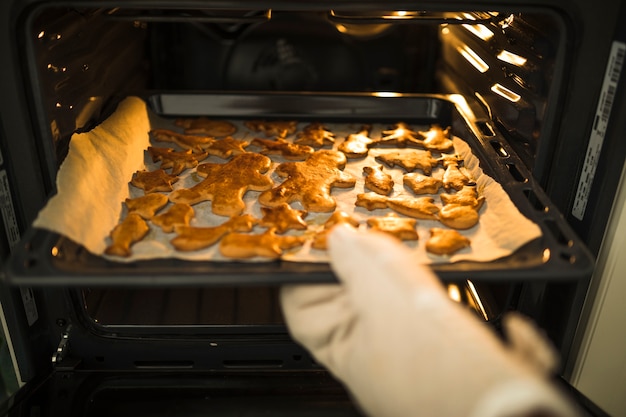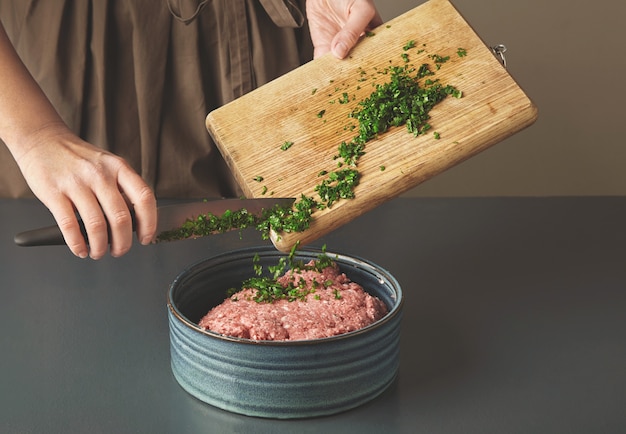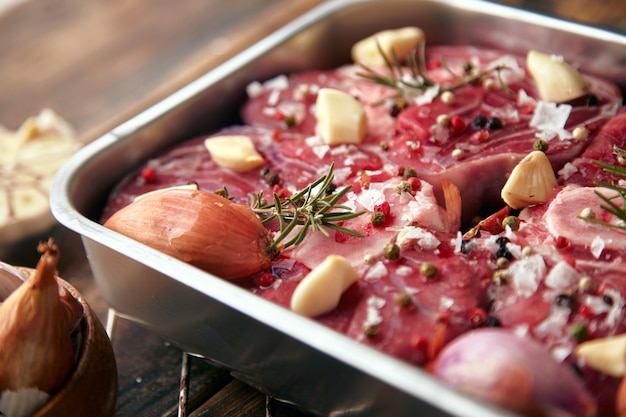Let's face it, there's nothing quite like a perfectly cooked ham, is there? It's a crowd-pleaser, a feast for the senses, and a guaranteed way to bring everyone to the table, whether it's a special occasion or just a Tuesday night. And when it comes to preparing that perfect ham, oven-baking is the way to go. It's simple, versatile, and delivers consistently delicious results, every single time. So, grab a cuppa, settle in, and let's dive into the world of oven-baked ham together.
(Part 1) The Ham Hunt: Choosing Your Culinary Champion

The first step on this delightful journey is picking your ham, and this is where things get exciting because you've got a whole spectrum of options to choose from! There are the magnificent bone-in hams, those impressive fellows that make a real statement on the table, perfect for a grand gathering. Then there's the boneless variety, often pre-sliced, which is a dream for those who prefer convenience and ease of carving. And let's not forget the different types of hams – spiral-sliced, bone-in, smoked, uncured… it's a ham-lover's paradise!
The Great Ham Debate: Bone-in vs. Boneless
Now, the age-old question: bone-in or boneless? This is where personal preference reigns supreme! I'm a big fan of bone-in hams. They tend to be more flavorful, and the bone acts like a natural heat conductor, ensuring even cooking. Plus, let's be honest, that bone marrow is pure culinary gold, a delicious treat for the adventurous soul! If you're after a classic, traditional ham, go bone-in. But if convenience and ease of carving are your priorities, boneless is your best bet. It's all about finding the ham that fits your culinary style and the occasion.
Uncured vs. Cured: A Matter of Flavor and Preference
Another important decision is whether you want an uncured or cured ham. uncured hams are often made with less salt and nitrates, making them a healthier choice for those who prefer a more natural approach. They also tend to have a milder flavor, letting the natural taste of the ham shine through. Cured hams, on the other hand, are known for their intense flavor, often with a salty or smoky edge, a result of the curing process. They're also naturally preserved, meaning they'll last longer in your fridge, perfect for those who enjoy a bit of planning. Ultimately, the choice between cured and uncured comes down to your taste preferences and dietary needs.
Fresh vs. Pre-Cooked: A Balancing Act of Time and Effort
Now, here's a decision that often sparks lively debate: fresh or pre-cooked? fresh hams are a real treat for those who enjoy the culinary challenge. They require more time and effort, but they offer an unparalleled depth of flavor and a texture that's simply divine. You're in control of the entire cooking process, ensuring the ham is cooked to your exact liking. pre-cooked hams, however, are a godsend for busy cooks. They're already cooked, so all you have to do is heat them up and enjoy. While they may not have the same depth of flavor as fresh hams, they're incredibly convenient and still offer a delicious experience. Ultimately, the choice depends on your available time, cooking skills, and the level of effort you're willing to invest.
(Part 2) Prepping for Perfection: The Art of the Ham Makeover

Alright, you've chosen your ham, you've got the oven preheated, and you're ready to get cooking! But before you pop that ham in the oven, there are a few essential steps to ensure a truly glorious result. Think of it as giving your ham a little makeover before its grand entrance.
The Art of Scoring: Enhancing Flavor and Visual Appeal
Scoring a ham is more than just an aesthetic touch; it's actually a crucial step that enhances flavor and improves the overall cooking process. Grab a sharp knife and make those diagonal cuts across the ham's fat layer. These cuts, known as scoring, allow for better browning, enabling the glaze to adhere more effectively, and creating those beautiful, golden brown streaks that are a hallmark of a perfectly baked ham. It's a simple step, but it makes a world of difference.
Glazing Up: A Symphony of Sweet and Savory
Speaking of glaze, let's talk about one of the most exciting aspects of baking a ham – the glaze! It's like adding the final flourish to a masterpiece. You can go classic with a honey mustard glaze, add a touch of sweetness with a brown sugar and maple syrup combination, or get adventurous with tangy Dijon mustard and a hint of brown sugar for that perfect balance of sweet and savory. Whatever your preference, ensure your glaze is thick enough to coat the ham evenly and stick to the surface during baking. It's the final touch that elevates your ham from good to absolutely irresistible.
Essential Equipment: A culinary arsenal for Success
Before we delve into the oven, let's make sure you have the right tools for the job. You'll need a roasting pan, preferably one with a rack to elevate the ham and allow for even cooking. A meat thermometer is also a must-have to ensure your ham is cooked to perfection. And don't forget a sturdy carving knife, ready to slice that delicious ham into perfect portions once it's done. You wouldn't want to ruin a beautiful ham with a dull blade, would you?
(Part 3) Baking to Perfection: The Heat of the Moment

Alright, your ham is prepped and ready to go, and the oven is preheated. This is where the magic happens, where anticipation builds, and the aroma of deliciousness begins to fill your kitchen.
Oven Temperature: Finding the Sweet Spot
Now, oven temperature is crucial. You want it hot enough to cook the ham evenly and create that beautiful golden crust, but not so hot that it burns the outside before the inside is cooked through. Most recipes recommend a temperature of around 325°F (160°C), but you can always adjust it depending on the size of your ham and your preferred level of doneness. It's all about finding that perfect balance.
cooking time: A Guide to Culinary Precision
The cooking time for a ham will vary depending on its size and whether it's fresh or pre-cooked. Generally, a fresh ham will take longer to cook than a pre-cooked one. A good rule of thumb is to allow about 15-20 minutes per pound of ham, but it's always best to check the internal temperature using a meat thermometer to ensure it's cooked through. Patience is key, and a little extra time ensures a perfect result.
The Importance of Internal Temperature: Safety and Flavor
This is where the meat thermometer truly earns its place in your kitchen. You want to make sure the ham reaches an internal temperature of 145°F (63°C) for safety and optimal flavor. A thermometer is your best friend, ensuring you're not overcooking or undercooking your ham. Remember, when it comes to food safety, it's always better to err on the side of caution.
(Part 4) The Art of Glazing: Transforming Delicious into Irresistible
We're nearing the end of our ham-baking journey, and it's time for the grand finale – glazing. This is the moment where your ham transforms from delicious to downright irresistible. It's the finishing touch that adds a touch of magic and transforms a good ham into a culinary masterpiece.
Glazing Techniques: A Step-by-Step Guide
Glazing is a bit of an art form, but it's surprisingly easy once you get the hang of it. Start by brushing your chosen glaze over the ham about halfway through the cooking time. This initial glaze creates a beautiful base for the final glaze and allows the flavors to meld. During the last 30 minutes of cooking, continue to baste the ham with glaze, ensuring it gets a beautiful golden brown color and a luscious, sticky finish that everyone will love.
Glazing Tips and Tricks: Maximizing Flavor and Visual Appeal
Here are a few tips to take your glazing skills to the next level:
- Use a pastry brush to apply the glaze evenly, ensuring all surfaces are coated.
- Don't be afraid to experiment with different glazes and flavors. Get creative and try something new!
- For a deeper glaze, add a tablespoon or two of water to the glaze before applying it to the ham. This helps the glaze penetrate the ham's surface.
- If your glaze is getting too thick, add a little bit of water or broth to thin it out. You want a smooth, even coating, not a thick, gloppy mess.
(Part 5) Resting and Carving: A Moment of Patience for Perfect Results
Your ham is finally cooked, and it looks absolutely stunning! But before you dive in, let that ham rest for about 15-20 minutes. This allows the juices to redistribute throughout the ham, ensuring a juicy, flavorful slice with every bite. A little patience now will reward you with a truly delicious experience.
The Art of Carving: Slicing with Confidence
Now, it's time for the grand reveal. Carving a ham can be a bit intimidating, but don't worry; it's not as hard as it looks. Here's a simple approach that will have you slicing like a pro:
- Start by removing the skin and any excess fat. You want to expose the beautiful, cooked ham underneath.
- If you're working with a bone-in ham, use a carving knife to carefully cut along the bone, separating the meat from the bone. It's best to follow the natural curves of the bone for clean, even slices.
- For a boneless ham, start at one end and make thin, even slices across the ham. You want nice, uniform slices that are easy to eat and showcase the deliciousness inside.
- Once you've carved the ham, arrange it beautifully on a platter for everyone to enjoy.
(Part 6) Serving with Style: side dishes that Complement the Ham
Your perfectly cooked and carved ham is ready to shine, but it needs a supporting cast to make the meal truly memorable. So, let's talk side dishes. They're like the perfect musical accompaniment to your main attraction, adding depth and harmony to the overall experience.
Classic Combos: Pairing Ham with Traditional Favourites
When it comes to side dishes, there are some classic pairings that never disappoint. They're the tried-and-true, the familiar comforts that make a ham dinner feel complete. Here are a few ideas to get you started:
- mashed potatoes: Creamy, comforting, and the perfect complement to the salty ham.
- green beans: A simple yet satisfying side that adds a touch of freshness and a bit of vibrant green to the plate.
- Macaroni and cheese: The ultimate comfort food, perfect for a cozy feast.
- Cornbread: A Southern classic that adds a touch of sweetness and a delightful crumbly texture.
- Asparagus: A healthy and elegant side dish that adds a touch of spring to your plate.
Beyond the Classics: Exploring New Flavour Combinations
But don't be afraid to get creative! There's a whole world of flavors waiting to be explored, and sometimes the most unexpected pairings can be the most delicious. Here are a few unconventional pairings that add a touch of excitement to your ham dinner:
- roasted brussels sprouts: These little gems become deliciously caramelized and nutty when roasted, offering a satisfying crunch and a unique flavor.
- sweet potato casserole: A touch of sweetness and a creamy texture make this a delightful pairing, contrasting beautifully with the savory ham.
- quinoa salad: A lighter and healthier option, packed with flavor and nutrients, perfect for those who prefer a more balanced meal.
- Roasted root vegetables: A medley of carrots, parsnips, and potatoes, roasted to perfection, offering a beautiful array of colors and textures.
- fruit salad: A refreshing and vibrant side dish that provides a nice contrast to the savory ham.
(Part 7) Leftover Love: Transforming Ham into a Culinary Treasure
Let's be honest, there's always a bit of ham left over. But don't despair, my friend! leftover ham is a culinary treasure, full of possibilities for delicious and satisfying meals that will make you happy you had that ham in the first place.
Sandwich Supreme: Ham and Cheese Dreams Come True
Who doesn't love a good ham and cheese sandwich? Use your leftover ham to create a masterpiece of bread, cheese, and delicious ham. Try adding a bit of mustard, pickles, or even some avocado for a touch of extra flavour. It's a simple, satisfying, and oh-so-delicious way to use up leftover ham.
Ham and Bean Extravaganza: A Hearty and Soulful Dish
Ham and beans – it's a classic pairing for a reason. Toss your leftover ham into a pot of beans with some onions, garlic, and spices for a comforting and satisfying meal. It's a perfect meal for a cold winter's day, providing warmth and sustenance.
Ham and Veggie Delights: A Light and Flavorful Option
Looking for a lighter meal? Combine your leftover ham with your favorite vegetables for a quick and healthy meal. Stir-fries, salads, and even pasta dishes all benefit from the deliciousness of leftover ham, adding a savory touch that elevates the dish.
(Part 8) FAQs: Your Ham-Baking Questions Answered
Here are a few commonly asked questions about oven-baked ham, answered in a straightforward and comprehensive way, ensuring you have all the information you need to create a ham masterpiece.
FAQs:
| Question | Answer |
|---|---|
| How long does it take to bake a ham? | The baking time depends on the size and type of ham. A fresh ham will take longer to cook than a pre-cooked ham. Generally, allow about 15-20 minutes per pound of ham. Always check the internal temperature to ensure it's cooked through. A meat thermometer is your best friend for this! |
| What is the best way to glaze a ham? | Start by brushing a glaze over the ham about halfway through the cooking time. Continue to baste the ham with glaze during the last 30 minutes of cooking, ensuring it gets a beautiful golden brown color and a luscious, sticky finish. A pastry brush is essential for this step, ensuring even application. |
| Can I freeze leftover ham? | Yes, you can freeze leftover ham for up to 3 months. Wrap it tightly in plastic wrap or foil, and then place it in a freezer bag. When you're ready to use it, thaw it in the refrigerator overnight. |
| How do I know if my ham is cooked through? | Use a meat thermometer to check the internal temperature of the ham. It should reach an internal temperature of 145°F (63°C) for safety and optimal flavor. |
| What are some good side dishes to serve with ham? | Classic side dishes include mashed potatoes, green beans, macaroni and cheese, cornbread, and asparagus. For a more creative touch, consider roasted Brussels sprouts, sweet potato casserole, quinoa salad, roasted root vegetables, or fruit salad. |
Everyone is watching

Prime Rib Roast Cooking Time Chart: Per Pound Guide
Cooking TipsPrime rib roast. Just the name conjures images of lavish dinners, crackling fires, and hearty laughter. It’s ...

How Long to Bake Potatoes in the Oven (Perfect Every Time)
Cooking TipsBaked potatoes are a staple in my kitchen. They're incredibly versatile, delicious, and surprisingly easy to m...

Perfect Rice Every Time: The Ultimate Guide to Cooking Rice
Cooking TipsAs a self-proclaimed foodie, I've always been a bit obsessed with rice. It's the foundation of countless cuisi...

The Ultimate Guide to Cooking Asparagus: Tips, Techniques, and Recipes
Cooking TipsAsparagus. The mere mention of this spring delicacy conjures up images of vibrant green spears, crisp and burs...

Ultimate Guide to Cooking the Perfect Thanksgiving Turkey
Cooking TipsThanksgiving. Just the word conjures up images of overflowing tables laden with delicious food, the scent of r...
